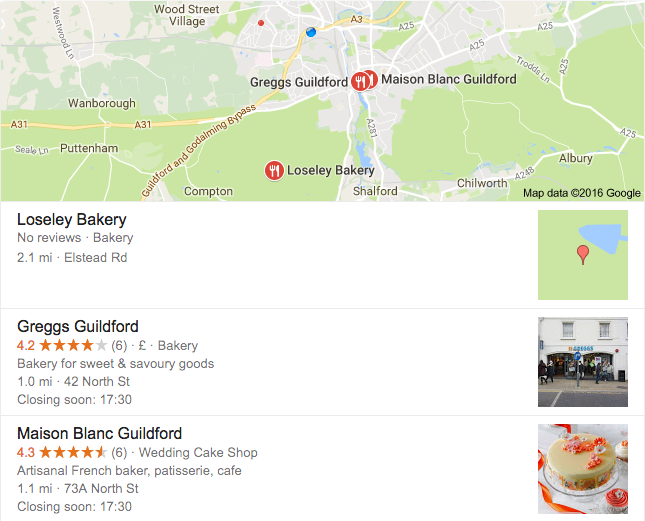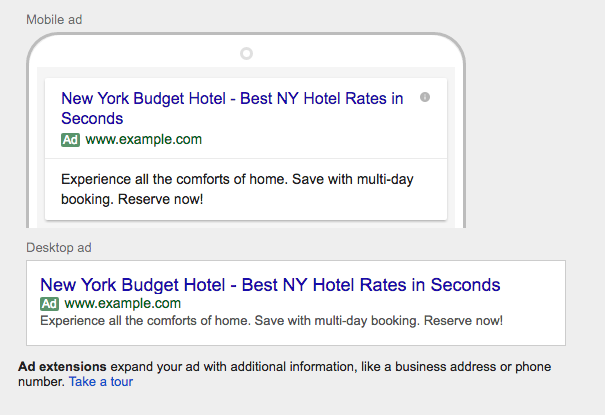There have been some recent changes and updates to Google Adwords which were presented at the 2016 Google Summit and are important for digital marketers in order for you to make the most of the new features. Google is continuing to emphasise a ‘mobile-first’ approach, which means that the look of the SERP is changing to make the mobile experience more favourable. Due to these changes, paid adverts need to be adapted to the mobile first world as well, therefore Google has recently announced its new and interesting changes that have been made to Adwords.
1. New Local Search Ads To Appear On Google Maps
Google has unveiled what it calls the ‘next generation’ of local search advertising. These new ads are to appear within Google Maps (on the app as well as both desktop and mobile versions of the site) in addition to across Google.com.
Within the new ads, a brands logo and their offers will appear directly on the surface of the map, rather than just alongside it. Clicking on these logos will lead to a mobile local inventory ad format.
So Why the Focus on Google Maps?
Over its course, Google Maps has accumulated over a billion users with people visiting 1.5 billion destinations based on their searches on Google. Location-related Google searches:
- Account for nearly a third of all mobile searches
- Have grown 50% faster than overall mobile searches in the past year
In order to drive more traffic online from Google Maps to local businesses, Google aims to introduce other new ad formats such as promotional pins. As well as this, Google are revamping local business pages, the two key changes of which are: Advertisers are able to highlight an in-store promotion, and users will be able to search the local inventory. This integration gives the advertisers the ability to add logos and offers.
These ads will show based on queries whilst Google is looking at several other context signals (similar to display advertising) such as a person’s personal browsing history, similar users, time of day, interests and behaviours. This will enable a good amount of local advertising inventory, as it is thought that people are just as likely to search for local businesses on Google search as well as Google Maps.

2. Expanded Text Ads Get Double Headlines & More Characters
Back in February of this year, Google eliminated right side ads from the desktop SERP in a bid to create a more unified Google experience across different devices. Now these text ads are undergoing a significant change.
With the new expanded text ads, the ad headlines are much bigger – so advertisers are able to have two 30-character headlines, a noticeable increase from the previous single headline of just 25 characters. During testing, it was found by Google that this change significantly increased an ads CTR (click-through rate), by almost as much as 25%.

It has been found that adding an ad extension or call extension to mobile text ads tends to increase CTR even further, so it is understandable and makes complete sense that the CTR’s for double headliners is even higher. In addition to a greater number of clicks, Google has said that longer headlines will be more useful for advertisers and will result in better quality traffic for advertisers.
This is an important and significant change when there is such little space on a smartphone screen, these changes to the headliners is great news for advertisers.

Not only this, but Google has also expanding advertisers character allowance for the description line of their ad, giving them the ability to write a single 80-character description line. The display URL has also been removed, as AdWords automatically extracts the domain from the final URL, advertisers then have the option to add in one or two paths in order to enhance the display URL.
These ad changes are happening to mobile & desktop ads, so its best practise to migrate your campaigns ad format as soon as possible so as to beat your competitors to bigger ads.
3. Better Measurement of In-Store Conversions
Advertisers are aware that people are clicking on their ads and that this is what drives traffic to their local businesses, but do they really know how much? AdWords can help a business bridge that gap between the digital and physical worlds by measuring in-store conversions. Soon, in-store conversions will become more widely available to a wider variety of businesses. Considering that 90% of sales happen in store as opposed to online, this is a critically important feature. Google will do this by looking at the person’s phone location history so as to determine whether or not the person who ended up waking into the store was the same person that searched and clicked on your ad.
4. New Responsive Display Ads
Google are going to start creating responsive display ads for you, using only a URL, headline, description and an image provided by you. Your ads will be able to adapt to and run on the content of the websites that they’re on and apps on the Google Display Network, including native ad inventory. By using Responsive Display Ads, Google is eliminating the hassle of creating ads for different formats, Google will now do this for you depending on the best format for your ad depending on which placement it is being served.
5. Changes to Device Bidding
On top of all the changes already mentioned, Google is also making changes to their bidding process on AdWords. Previously, advertisers were required to set a standard desktop bid as well as setting mobile bids as a multiplier on top the of base bid. This has been introduced alongside Enhanced Campaigns. Moving forward, you will now have the ability to set mobile bids, desktop bids, and tablet bids independently or make them dependent on each other. This will give advertisers more flexibility and further enforces Google’s mobile-first approach.
We are living in an increasingly mobile orientated world. More than 50% of the trillions of searches conducted on Google each year come from mobile devices. This is why Google is innovating in mobile so as to provide a compelling experience for its users to ensure that advertisers are able to reach consumers at the best possible moment.
To make sure you’re attracting and converting mobile searches when people are using commercial search queries and quickly find a business, you’ll want to make sure you’ve leveraged your mobile ad formats so as to beat your competitors.







